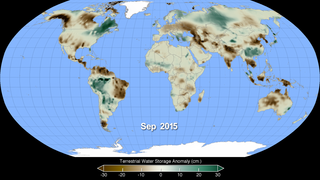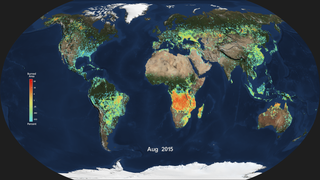Earth
ID: 4413
Every two to seven years, an unusually warm pool of water, sometimes two to three degrees Celsius higher than normal, develops across the eastern tropical Pacific Ocean to create a natural short-term climate change event. This warm condition, known as El Niño, affects the local aquatic environment, but also spurs extreme weather patterns around the world, from flooding in California to droughts in Australia.
Sea Surface Temperature Anomalies (SSTA) show ocean regions with warmer or colder temperatures than the long-term average for a given month. Globally, SSTA are an important driver of atmospheric circulation and rainfall patterns. Climate modes such as the El Niño Southern Oscillation (ENSO) in the tropical Pacific Ocean, including El Niño (warm SSTA) and La Niña (cold SSTA) phases, give us rise to predictable changes in rainfall patterns. The strong El Niño event that developed in 2015 appears as warm SSTA in the eastern Pacific Ocean.
For more information on the GEOS5 mission please visit http://www.nasa.gov/mission_pages/Grace/


Sea Surface Temperature Anomaly and Terrestrial Water Storage Anomaly Comparison
Sea Surface Temperature Anomalies (SSTA) show ocean regions with warmer or colder temperatures than the long-term average for a given month. Globally, SSTA are an important driver of atmospheric circulation and rainfall patterns. Climate modes such as the El Niño Southern Oscillation (ENSO) in the tropical Pacific Ocean, including El Niño (warm SSTA) and La Niña (cold SSTA) phases, give us rise to predictable changes in rainfall patterns. The strong El Niño event that developed in 2015 appears as warm SSTA in the eastern Pacific Ocean.
For more information on the GEOS5 mission please visit http://www.nasa.gov/mission_pages/Grace/


Related
Visualization Credits
Alex Kekesi (Global Science and Technology, Inc.): Lead Visualizer
Cindy Starr (Global Science and Technology, Inc.): Visualizer
Kel Elkins (USRA): Visualizer
Doug C. Morton (NASA/GSFC): Lead Scientist
Yang Chen (University of California, Irvine): Lead Scientist
Jim Randerson (University of California, Irvine): Lead Scientist
Cindy Starr (Global Science and Technology, Inc.): Visualizer
Kel Elkins (USRA): Visualizer
Doug C. Morton (NASA/GSFC): Lead Scientist
Yang Chen (University of California, Irvine): Lead Scientist
Jim Randerson (University of California, Irvine): Lead Scientist
Please give credit for this item to:
NASA's Scientific Visualization Studio
NASA's Scientific Visualization Studio
Short URL to share this page:
https://svs.gsfc.nasa.gov/4413
Missions:
Fire and Smoke
Gravity Recovery and Climate Experiment (GRACE)
Data Used:
Note: While we identify the data sets used in these visualizations, we do not store any further details nor the data sets themselves on our site.
Keywords:
DLESE >> Biology
DLESE >> Ecology
SVS >> El Nino
DLESE >> Human geography
SVS >> La Nina
DLESE >> Natural hazards
SVS >> Sea Surface Temperature Anomaly
GCMD >> Earth Science >> Climate Indicators >> Fire Weather Indices
GCMD >> Earth Science >> Biosphere >> Ecological Dynamics >> Fire Characteristics
GCMD >> Earth Science >> Biosphere >> Ecological Dynamics >> Fire Occurrence
GCMD >> Earth Science >> Climate Indicators >> Fire Weather Indices >> Fire Weather Index
GCMD >> Earth Science >> Climate Indicators >> Teleconnections >> El Nino Southern Oscillation
GCMD >> Earth Science >> Human Dimensions >> Natural Hazards >> Fires
SVS >> Hyperwall
SVS >> Earth Science >> El Nino
NASA Science >> Earth
GCMD >> Earth Science >> Biosphere >> Ecological Dynamics >> Fire Ecology
GCMD >> Earth Science >> Climate Indicators >> Atmospheric/ocean Indicators >> Sea Surface Temperature Indices
GCMD >> Earth Science >> Climate Indicators >> Land Surface/agriculture Indicators >> Fire Weather Index
GCMD >> Earth Science >> Climate Indicators >> Terrestrial Hydrosphere Indicators
GCMD >> Earth Science >> Human Dimensions >> Environmental Governance/management >> Fire Management
GCMD >> Earth Science >> Terrestrial Hydrosphere
GCMD keywords can be found on the Internet with the following citation: Olsen, L.M., G. Major, K. Shein, J. Scialdone, S. Ritz, T. Stevens, M. Morahan, A. Aleman, R. Vogel, S. Leicester, H. Weir, M. Meaux, S. Grebas, C.Solomon, M. Holland, T. Northcutt, R. A. Restrepo, R. Bilodeau, 2013. NASA/Global Change Master Directory (GCMD) Earth Science Keywords. Version 8.0.0.0.0
https://svs.gsfc.nasa.gov/4413
Missions:
Fire and Smoke
Gravity Recovery and Climate Experiment (GRACE)
Data Used:
NOAA Optimum Interpolation Sea Surface Temperature also referred to as: OISSTv2
NOAA - 1/2002 - 9/2015Gravity Recovery and Climate Experiment (GRACE)/Terrestrial Water Storage Anomaly also referred to as: TWS Anomaly
Analysis - 1/2002 - 9/2015Keywords:
DLESE >> Biology
DLESE >> Ecology
SVS >> El Nino
DLESE >> Human geography
SVS >> La Nina
DLESE >> Natural hazards
SVS >> Sea Surface Temperature Anomaly
GCMD >> Earth Science >> Climate Indicators >> Fire Weather Indices
GCMD >> Earth Science >> Biosphere >> Ecological Dynamics >> Fire Characteristics
GCMD >> Earth Science >> Biosphere >> Ecological Dynamics >> Fire Occurrence
GCMD >> Earth Science >> Climate Indicators >> Fire Weather Indices >> Fire Weather Index
GCMD >> Earth Science >> Climate Indicators >> Teleconnections >> El Nino Southern Oscillation
GCMD >> Earth Science >> Human Dimensions >> Natural Hazards >> Fires
SVS >> Hyperwall
SVS >> Earth Science >> El Nino
NASA Science >> Earth
GCMD >> Earth Science >> Biosphere >> Ecological Dynamics >> Fire Ecology
GCMD >> Earth Science >> Climate Indicators >> Atmospheric/ocean Indicators >> Sea Surface Temperature Indices
GCMD >> Earth Science >> Climate Indicators >> Land Surface/agriculture Indicators >> Fire Weather Index
GCMD >> Earth Science >> Climate Indicators >> Terrestrial Hydrosphere Indicators
GCMD >> Earth Science >> Human Dimensions >> Environmental Governance/management >> Fire Management
GCMD >> Earth Science >> Terrestrial Hydrosphere
GCMD keywords can be found on the Internet with the following citation: Olsen, L.M., G. Major, K. Shein, J. Scialdone, S. Ritz, T. Stevens, M. Morahan, A. Aleman, R. Vogel, S. Leicester, H. Weir, M. Meaux, S. Grebas, C.Solomon, M. Holland, T. Northcutt, R. A. Restrepo, R. Bilodeau, 2013. NASA/Global Change Master Directory (GCMD) Earth Science Keywords. Version 8.0.0.0.0













